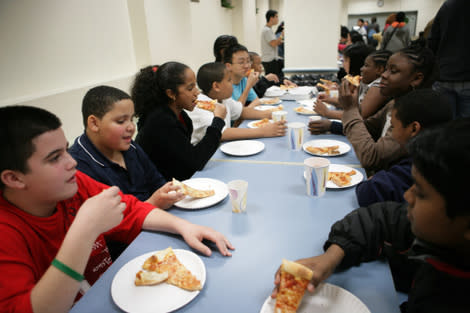Pizza is a Vegetable, Congress Says, Blocking Attempts to Make School Lunches Healthier

Thirty years ago, the Reagan Administration was taken to task for classifying ketchup as a vegetable in order to cut the cost of school lunches. And now Congress is trying something similar: In a spending bill released late Monday night, lawmakers insisted that a slice of pizza be considered a vegetable, thanks to the two tablespoons or so of tomato paste smeared under the layer of goopy, processed-cheese product.
In January, the U.S. Department of Agriculture had proposed limiting the amount of starchy vegetables (like potatoes, mostly in the form of french fries, but also corn and peas) to two servings per week in order to "encourage students to try new vegetables in place of the familiar starchy ones."
Their proposal, which was based on 2009 recommendations by the National Academy of Sciences and the Institute of Medicine, also called for reducing sodium, increasing the use of whole grains, and quadrupling the amount of tomato paste needed in order for it to qualify as a serving of veggies.
But lawmakers on Monday blocked limits on starchy vegetables, including French fries, which some schools serve every day, the Associated Press reported. They also decided to maintain the "two tablespoons of tomato sauce equals a serving of vegetables" equation in federally subsidized school lunch programs, and postponed requirements on sodium reduction and whole grains.
"The conference agreement includes provisions to prevent overly burdensome and costly regulations and to provide greater flexibility for local school districts to improve the nutritional quality of meals," House Appropriations Committee Chairman Hal Rogers said in a statement. "Without these provisions, the cost of these important programs would balloon by an additional $7 billion over the next five years."
The push to avoid changing the school lunch menu was led by the salt industry, potato-growing states, the American Frozen Food Institute, and other companies, the Associated Press reported.
"It's a shame that Congress seems more interested in protecting industry than protecting children's health," Margo G. Wootan, the director of the Center for Science in the Public Interest, said in a statement. "At a time when child nutrition and childhood obesity are national health concerns, Congress should be supporting USDA and school efforts to serve healthier school meals, not undermining them."
Retired military leaders point out that one out of four young adults are too overweight to join the military, which could jeopardize national security in the long run.
"Obesity is the leading medical reason why applicants fail to qualify for military service. Otherwise excellent recruit prospects are being turned away because they are simply too heavy," former Chairman of the Joint Chiefs of Staff Hugh Shelton and more than 100 other retired generals and admirals wrote in an open letter to Congress on Monday. "As much as 40 percent of a child's daily caloric intake occurs at school. Properly managed, the school environment can be instrumental in fostering healthful eating habits for our children."
"We urge you to reject any language … that would weaken the proposed guidelines for school meals or derail the implementation process," they wrote.
But food industry representatives lauded the lawmakers for keeping the highly caloric, fat- and sodium-laden options intact.
"This agreement ensures that nutrient-rich vegetables such as potatoes, corn and peas will remain part of a balanced, healthy diet in federally funded school meals and recognizes the significant amounts of potassium, fiber and vitamins A and C provided by tomato paste, ensuring that students may continue to enjoy healthy meals such as pizza and pasta," Kraig Naasz, president of the American Frozen Food Institute, told the Associated Press.
For the record: A two-tablespoon serving of tomato paste provides 4 percent of the U.S. recommended daily value of potassium (150 mg), 10 percent of the recommended daily values for Vitamins A and C, and a single gram of fiber, which is about 6 percent of what people should consume daily. Which doesn't sound too bad--until you consider the high amounts of sugar, fat, and sodium that's also in that slice of school-lunch pizza.
No one is saying schools shouldn't serve french fries or pizza. But maybe consider serving a slice with a side of actual vegetables, instead of insisting that a smear of sauce is the same as helping of broccoli?
Also on Shine:
